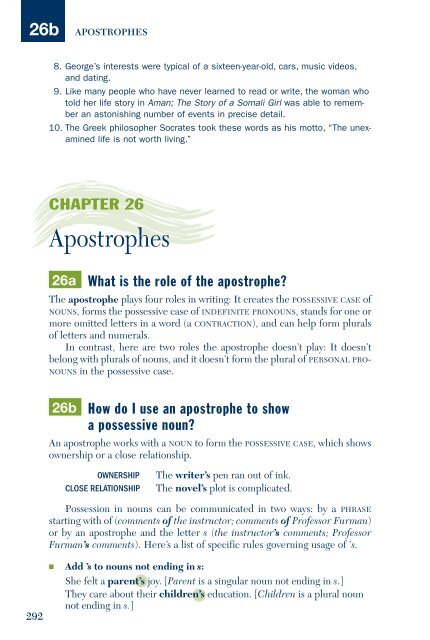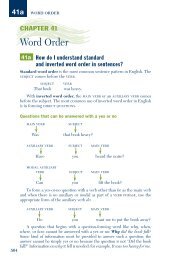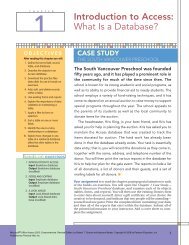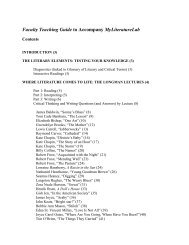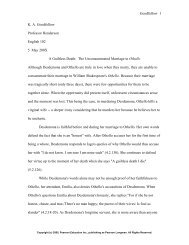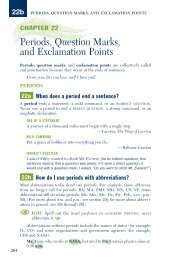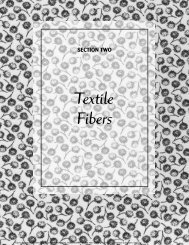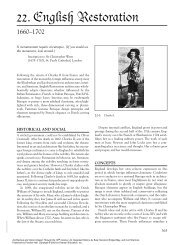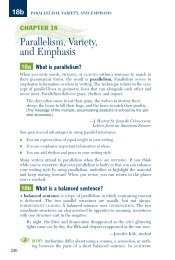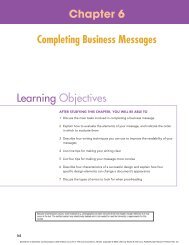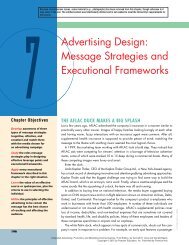Chapter 26: Apostrophes eBook - Pearson Learning Solutions
Chapter 26: Apostrophes eBook - Pearson Learning Solutions
Chapter 26: Apostrophes eBook - Pearson Learning Solutions
Create successful ePaper yourself
Turn your PDF publications into a flip-book with our unique Google optimized e-Paper software.
<strong>26</strong>b APOSTROPHES<br />
292<br />
8. George’s interests were typical of a sixteen-year-old, cars, music videos,<br />
and dating.<br />
9. Like many people who have never learned to read or write, the woman who<br />
told her life story in Aman; The Story of a Somali Girl was able to remember<br />
an astonishing number of events in precise detail.<br />
10. The Greek philosopher Socrates took these words as his motto, “The unexamined<br />
life is not worth living.”<br />
CHAPTER <strong>26</strong><br />
<strong>Apostrophes</strong><br />
<strong>26</strong>a What is the role of the apostrophe?<br />
The apostrophe plays four roles in writing: It creates the POSSESSIVE CASE of<br />
NOUNS, forms the possessive case of INDEFINITE PRONOUNS, stands for one or<br />
more omitted letters in a word (a CONTRACTION), and can help form plurals<br />
of letters and numerals.<br />
In contrast, here are two roles the apostrophe doesn’t play: It doesn’t<br />
belong with plurals of nouns, and it doesn’t form the plural of PERSONAL PRO-<br />
NOUNS in the possessive case.<br />
<strong>26</strong>b How do I use an apostrophe to show<br />
a possessive noun?<br />
An apostrophe works with a NOUN to form the POSSESSIVE CASE, which shows<br />
ownership or a close relationship.<br />
OWNERSHIP The writer’s pen ran out of ink.<br />
CLOSE RELATIONSHIP The novel’s plot is complicated.<br />
Possession in nouns can be communicated in two ways: by a PHRASE<br />
starting with of (comments of the instructor; comments of Professor Furman)<br />
or by an apostrophe and the letter s (the instructor’s comments; Professor<br />
Furman’s comments). Here’s a list of specific rules governing usage of ’s.<br />
■ Add ’s to nouns not ending in s:<br />
She felt a parent’s joy. [Parent is a singular noun not ending in s.]<br />
They care about their children’s education. [Children is a plural noun<br />
not ending in s.]
How do I use an apostrophe with possessive pronouns? <strong>26</strong>c<br />
■ Add ’s to singular nouns ending in s:<br />
You can add ’s or the apostrophe alone to show possession when a singular<br />
noun ends in s. In this handbook, I use ’s to clearly mark singular-noun possessives,<br />
no matter what letter ends the noun. Whichever rule variation you<br />
choose, be consistent within each piece of writing.<br />
The bus’s (or bus’) air conditioning is out of order.<br />
Chris’s (or Chris’) ordeal ended.<br />
If you encounter a tongue-twisting pronunciation (Charles Dickens’s<br />
novel), you may decide not to add the additional s (Charles Dickens’ novel).<br />
You must, however, be consistent in each piece of writing.<br />
■ Add only an apostrophe to a plural noun ending in s:<br />
The boys’ statements were taken seriously.<br />
Three months’ maternity leave is in the workers’ contract.<br />
■ Add ’s to the last word in compound words and phrases:<br />
His mother-in-law’s corporation has bought out a competitor.<br />
The tennis player’s strategy was brilliant.<br />
We want to hear the caseworker’s recommendation.<br />
■ Add ’s to each noun in individual possession:<br />
Shirley’s and Kayla’s houses are next to each other. [Shirley and Kayla<br />
each own a house; they don’t own the houses jointly.]<br />
■ Add ’s to only the last noun in joint or group possession:<br />
Kareem and Brina’s house has a screened porch. [Kareem and Brina<br />
own one house.]<br />
Avram and Justin’s houses always have nice lawns. [Avram and Justin jointly<br />
own more than one house.]<br />
<strong>26</strong>c How do I use an apostrophe<br />
with possessive pronouns?<br />
When a POSSESSIVE PRONOUN ends with the letter s (hers, his, its, ours, yours,<br />
and theirs), never add an apostrophe. Below is a list of PERSONAL PRONOUNS<br />
and their possessive forms.<br />
PERSONAL PRONOUNS POSSESSIVE FORMS<br />
I my, mine<br />
you your, yours<br />
he his<br />
she her, hers<br />
it its<br />
we our, ours<br />
they their, theirs<br />
who whose<br />
293
<strong>26</strong>f APOSTROPHES<br />
294<br />
<strong>26</strong>d How do I use an apostrophe<br />
with contractions?<br />
In a contraction, an apostrophe takes the place of one or more omitted letters.<br />
Be careful not to confuse a contraction with a POSSESSIVE PRONOUN.<br />
Doing so is a common spelling error, one that many people—including<br />
employers—consider evidence of a poor education. Whether or not that’s<br />
fair, it’s usually true.<br />
it’s (contraction for it is) its (possessive pronoun)<br />
they’re (contraction for they are) their (possessive pronoun)<br />
who’s (contraction for who is) whose (possessive form of who)<br />
you’re (contraction for you are) your (possessive pronoun)<br />
NO The government has to balance it’s budget.<br />
YES The government has to balance its budget.<br />
NO The professor who’s class was canceled is ill.<br />
YES The professor whose class was canceled is ill.<br />
Although contractions are acceptable in many forms of writing, most<br />
instructors prefer that you avoid them in ACADEMIC WRITING.<br />
ALERT: One contraction required in all writing is o’clock (which<br />
stands for of the clock, an expression used long ago).<br />
<strong>26</strong>e How do I use an apostrophe with possessive<br />
indefinite pronouns?<br />
An apostrophe works with an INDEFINITE PRONOUN (see list in Box 10-6 in 10h)<br />
to form the POSSESSIVE CASE, which shows ownership or a close relationship.<br />
OWNERSHIP Everyone’s dinner is ready.<br />
CLOSE RELATIONSHIP Something’s aroma is appealing.<br />
Possession in indefinite pronouns can be communicated in two ways: by a<br />
PHRASE starting with of (comments of everyone) or by an apostrophe and the<br />
letter s (everyone’s comments).<br />
<strong>26</strong>f How do I form the plural<br />
of miscellaneous elements?<br />
Until recently, the plural of elements such as letters meant as letters, words<br />
meant as words, numerals, and symbols could be formed by adding either ’s<br />
or s. The most current MLA guidelines endorse the use of s only, with the<br />
exception of adding ’s to letters meant as letters. MLA requires underlining—<br />
never italics—for two elements only: (1) letters meant as letters and
When is an apostrophe wrong? <strong>26</strong>g<br />
(2) words meant as words. Don’t underline the s or ’s that creates the plural<br />
for any of the elements discussed in this section. (For published books, any<br />
underlined words in a manuscript are printed in italics, as is done in this<br />
handbook.) The examples below reflect MLA practices.<br />
PLURAL OF LETTERS MEANT Printing M’s and N’s confuses young<br />
AS LETTERS children.<br />
Printing m’s and n’s confuses young<br />
children.<br />
PLURAL OF LETTERS MEANT He was surprised to get all Bs in his<br />
AS WORDS courses.<br />
PLURAL OF WORDS MEANT Too many ifs in a contract make me<br />
AS WORDS suspicious.<br />
PLURAL OF NUMBERS Her e-mail address contains many 7s.<br />
PLURAL OF YEARS I remember the 1990s well.<br />
PLURAL OF SYMBOLS What do those &s mean?<br />
<strong>26</strong>g When is an apostrophe wrong?<br />
If you’re a writer who makes the same apostrophe errors repeatedly, memorize<br />
the rules you need (some you likely know almost without thought).<br />
Then, you won’t be annoyed by “that crooked little mark,” a nickname popular<br />
with students who wish the apostrophe would go away. Box <strong>26</strong>-1 lists the<br />
major apostrophe errors.<br />
Avoiding apostrophe errors<br />
BOX <strong>26</strong>-1 SUMMARY<br />
■ Never use an apostrophe with the PRESENT-TENSE VERB.<br />
Cholesterol plays [not play’s] an important role in how long we live.<br />
■ Always use an apostrophe after the s in a POSSESSIVE plural of a noun.<br />
Patients’ [not Patients] questions seek detailed answers.<br />
■ Never add an apostrophe at the end of a nonpossessive noun ending in s.<br />
Medical studies [not studies’ or study’s] show this to be true.<br />
■ Never use an apostrophe to form a nonpossessive plural.<br />
Teams [not Team’s] of doctors have studied the effects of cholesterol.<br />
EXERCISE <strong>26</strong>-1 Rewrite these sentences to insert ’s or an apostrophe<br />
alone to make the words in parentheses show possession. (Delete the<br />
parentheses.) For help, consult <strong>26</strong>b and <strong>26</strong>e.<br />
295
27a QUOTATION MARKS<br />
296<br />
EXAMPLE All boxes, cans, and bottles on a (supermarket) shelves are<br />
designed to appeal to (people) emotions.<br />
All boxes, cans, and bottles on a supermarket’s shelves are<br />
designed to appeal to people’s emotions.<br />
1. A (product) manufacturer designs packaging to appeal to (consumers)<br />
emotions through color and design.<br />
2. Marketing specialists know that (people) beliefs about a (product) quality<br />
are influenced by their emotional response to the design of its package.<br />
3. Circles and ovals appearing on a (box) design supposedly increase a (product<br />
user) feelings of comfort, while bold patterns and colors attract a<br />
(shopper) attention.<br />
4. Using both circles and bold designs in (Arm & Hammer) and (Tide) packaging<br />
produces both effects in consumers.<br />
5. (Heinz) ketchup bottle and (Coca-Cola) famous logo achieve the same effects<br />
by combining a bright color with an old-fashioned, “comfortable” design.<br />
6. Often, a (company) marketing consultants will custom-design products to<br />
appeal to the supposedly “typical” (adult female) emotions or to (adult<br />
males), (children), or (teenagers) feelings.<br />
7. One of the (marketing business) leading consultants, Stan Gross, tests (consumers)<br />
emotional reactions to (companies) products and their packages by<br />
asking consumers to associate products with well-known personalities.<br />
8. Thus, (test takers) responses to (Gross) questions might reveal that a particular<br />
brand of laundry detergent has (Sylvester Stallone) toughness,<br />
(Oprah Winfrey) determination, or (someone else) sparkling personality.<br />
9. Manufacturing (companies) products are not the only ones relying on<br />
(Gross) and other corporate (image makers) advice.<br />
10. (Sports teams) owners also use marketing specialists to design their<br />
(teams) images, as anyone who has seen the angry bull logo of the<br />
Chicago Bulls basketball team will agree.<br />
CHAPTER 27<br />
Quotation Marks<br />
27a What is the role of quotation marks?<br />
Quotation marks are used most often to enclose direct quotations—the<br />
exact spoken or written words of a speaker or writer. Quotation marks also<br />
set off some titles, and quotation marks can call attention to words used in a<br />
special sense.


